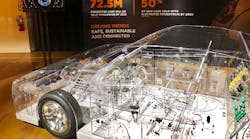The electric connector and sensor solution market is becoming more important to the ever-expanding world of the Internet of Things and automation. According to ConnectorSupplier.com, the top 10 connector manufacturers as a group achieved $32 billion in annual sales in 2016, equating to 59.8% of the world’s connector demand.
At the top of that list is TE Connectivity, which recently held its Investor Day to discuss the company’s investments, market trends, and how the future taking shape for electric connectors.
TE Connectivity’s CEO Terrence Curtin discusses how the key investments for TE must touch up on four major categories: safety, sustainability, productivity, and connectivity.
The largest area of growth and potential is the automotive market. Here at Machine Design, we have reported how several countries are creating mandates to go electric. This year saw France mandate the end of petrol and diesel car sales by 2040. The United Kingdom followed suit, setting the same deadline.
Norway, India, the Netherlands, Germany, and China are pushing their own government mandates to increase the sale of electric vehicles. China especially has increased the taxes on the sale of gasoline vehicles, and provided free vehicle registration for electric vehicles (EVs). Companies like Ford and GM are also committing to produce more electric cars for their fleet, with Ford committing to launch 13 EVs by 2020 and GM committing to 20 by 2023.
According to TE’s annual report, 72.5 million connected cars will be sold by 2023, and up to 50% of cars will have an electrified powertrain by 2030. The potential of EVs and autonomous vehicles line up well with TE’s portfolio. The consumer level of adoption currently sits at Level 1—driver assistance with sensors and simple data connectivity. TE is poised to automate the car all the way to Level 5—full automation with no driver input required. Its product line includes smart antenna technology, connector systems, battery disconnect, weight sensors, and impact sensors.
Steve Merkt, Transportation Group President for TE, highlights how the company plans to provide connective solutions for each autonomous level of the electric-vehicle evolution.
For TE, the hybrid/EV market is poised to represent 35% of its compound annual growth rate by 2024. Half of that growth will be driven by the Asia market. In his presentation at Investor’s Day, Steve Merkt, President of TE’s Transportation Group, stated that the China market had the largest growth potential due to government incentives, the need to lower pollution, and a strong emerging middle class.
Merkt said the barriers of adoption are multifaceted. The lack of infrastructure, such as charging stations and consumer concerns of vehicle range and high price points, have impeded consumers from buying EVs. As car manufacturers continue to produce more efficient EVs and government regulation helps mass adoption, consumer purchases of EVs will increase.
The see-through vehicle on display highlights all of the connected components that TE provides for the electric-vehicle market.
Along with the car market, TE highlighted its expanding role in the surging industrial automation and communication markets. Industrial automation has been preparing for a big push, and TE continues to work with OEMs to help develop their products. The top four applications for development are robotics, servomotors, servodrives, and programmable logic controllers. Combined, the four markets have grown 7%.
Factory equipment has increased 25%, driven by the change from hydraulic to electronic actuation, increased connectivity and remote access, robotics, safety enhancements, and retrofit/upgrades of legacy equipment. The communication market is driven by big data and the devices needed to store and connect the data. TE has partnered with some of the key market players, such as Cisco, HP Enterprise, and Microsoft.
The connected world isn’t only connecting devices—it is connecting disciplines, too. What once was considered solely mechanically driven spaces are now being integrated with electrical connections, sensors, and wireless systems. As the automotive industry and automation industry become more and more “electrified,” we can expect the demand to soar for these types of devices.




